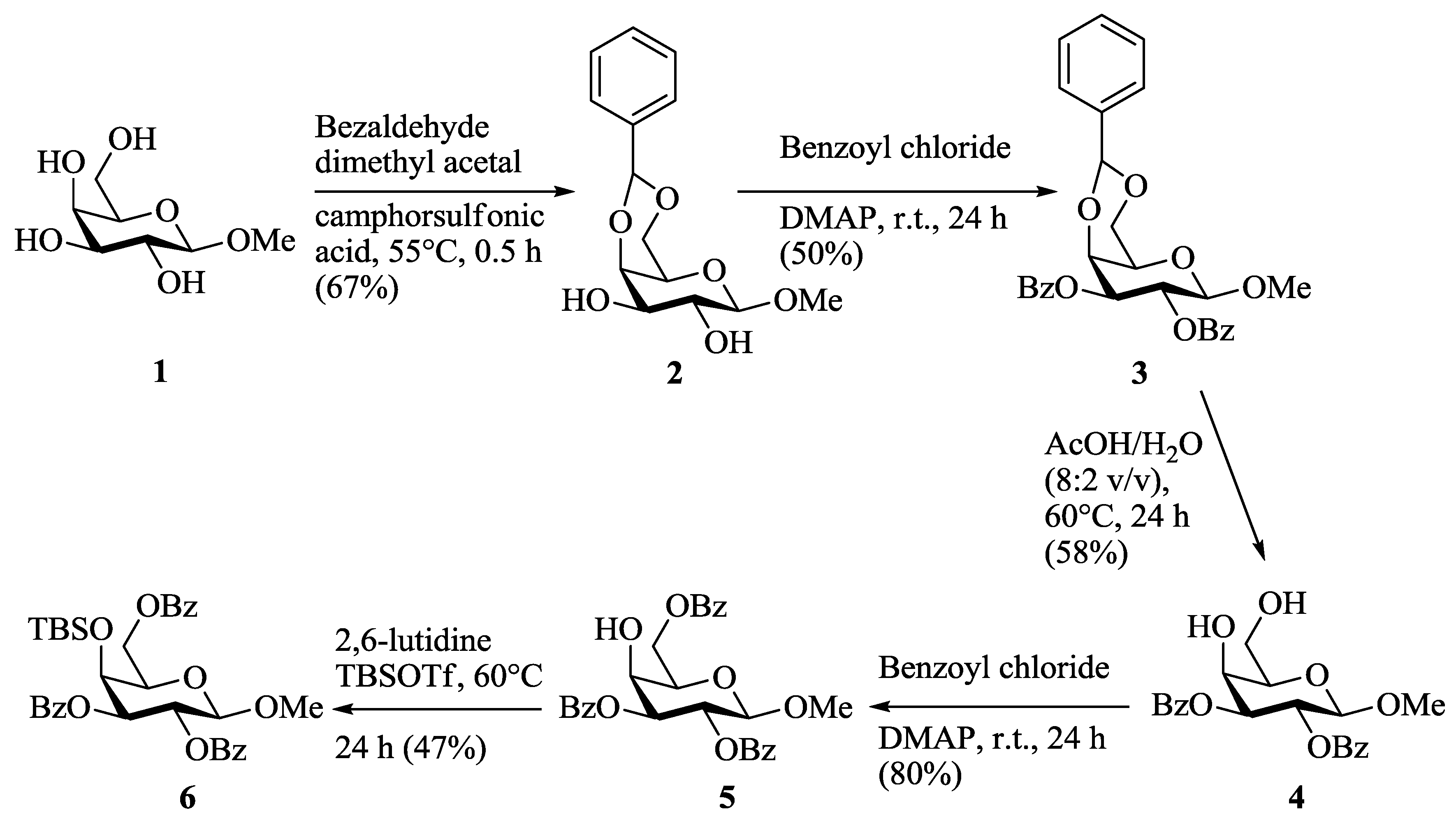Methyl 2,3,6-tri-O-Benzoyl-4-O-(tert-butyldimethylsilyl)-β-d-galactopyranoside
Abstract
:1. Introduction
2. Results and Discussion
3. Materials and Methods
3.1. General Information
3.2. Methyl 4,6-O-Benzylidene-β-d-galactopyranoside (2)
3.3. Methyl 4,6-O-Benzylidene-2,3-di-O-benzoyl-β-d-galactopyranoside (3)
3.4. Methyl 2,3-di-O-Benzoyl-β-d-galactopyranoside (4)
3.5. Methyl 2,3,6-tri-O-Benzoyl-β-d-galactopyranoside (5)
3.6. Methyl 2,3,6-tri-O-Benzoyl-4-O-(tert-butyldimethylsilyl)-β-d-galactopyranoside (6)
Supplementary Materials
Acknowledgments
Author Contributions
Conflicts of Interest
References
- Chen, R.; Jin, C.; Tong, Z.; Lu, J.; Tan, L.; Tian, L.; Chang, Q. Optimization Extraction, Characterization and Antioxidant Activities of Pectic Polysaccharide from Tangerine Peels. Carbohydr. Polym. 2016, 136, 187–197. [Google Scholar] [CrossRef] [PubMed]
- Choi, E.J.; Kim, J.W.; Kim, S.J.; Seo, S.O.; Lane, S.; Park, Y.C.; Jin, Y.S.; Seo, J.H. Enhanced Production of 2,3-Butanediol in Pyruvate Decarboxylase-Deficient Saccharomyces Cerevisiae through Optimizing Ratio of Glucose/galactose. Biotechnol. J. 2016, 11, 1424–1432. [Google Scholar] [CrossRef] [PubMed]
- Glinsky, V.V.; Kiriakova, G.; Glinskii, O.V.; Mossine, V.V.; Mawhinney, T.P.; Turk, J.R.; Glinskii, A.B.; Huxley, V.H.; Price, J.E.; Glinsky, G.V. Synthetic Galectin-3 Inhibitor Increases Metastatic Cancer Cell Sensitivity to Taxol-Induced Apoptosis In Vitro and In Vivo. Neoplasia 2009, 11, 901–909. [Google Scholar] [CrossRef] [PubMed]
- Öberg, C.T.; Leffler, H.; Nilsson, U.J. Arginine Binding Motifs: Design and Synthesis of Galactose-Derived Arginine Tweezers as Galectin-3 Inhibitors. J. Med. Chem. 2008, 51, 2297–2301. [Google Scholar] [CrossRef] [PubMed]
- Motoki, K.; Kobayashi, E.; Uchida, T.; Fukushima, H.; Koezuka, Y. Antitumour Activities of α-, β-Monoglycosylceramides and Four Diastereomers of an α-Galactosylceramide. Bioorg. Med. Chem. Lett. 1995, 5, 705–710. [Google Scholar] [CrossRef]
- Pilgrim, W.; O’Reilly, C.; Murphy, P.V. Synthesis of α-O- and α-S-Glycosphingolipids Related to Sphingomonous Cell Wall Antigens Using Anomerisation. Molecules 2013, 18, 11198–11218. [Google Scholar] [CrossRef] [PubMed]
- Pilgrim, W.; Murphy, P.V. SnCl4- and TiCl4-Catalyzed Anomerization of Acylated O- and S-Glycosides: Analysis of Factors That Lead to Higher α:β Anomer Ratios and Reaction Rates. J. Org. Chem. 2010, 75, 6747–6755. [Google Scholar] [CrossRef] [PubMed]
- O’Brien, C.; Polakova, M.; Pitt, N.; Tosin, M.; Murphy, P.V. Glycosidation-Anomerisation Reactions of 6,1-Anhydroglucopyranuronic Acid and Anomerisation of β-d-Glucopyranosiduronic Acids Promoted by SnCl4. Chem. Eur. J. 2007, 13, 902–909. [Google Scholar] [CrossRef] [PubMed]
- Farrell, M.; Zhou, J.; Murphy, P.V. Regiospecific Anomerisation of Acylated Glycosyl Azides and Benzoylated Disaccharides by Using TiCl4. Chem. Eur. J. 2013, 19, 14836–14851. [Google Scholar] [CrossRef] [PubMed]
- Angles d’Ortoli, T.; Widmalm, G. Synthesis of the Tetrasaccharide Glycoside Moiety of Solaradixine and Rapid NMR-Based Structure Verification Using the Program CASPER. Tetrahedron 2016, 72, 912–927. [Google Scholar] [CrossRef]
- Esmurziev, A.; Simic, N.; Sundby, E.; Hoff, B.H. 1H- and 13C-NMR data of methyl tetra-O-benzoyl-d-pyranosides in acetone-d6. Magn. Reson. Chem. 2009, 47, 449–452. [Google Scholar] [CrossRef] [PubMed]
- Abdu-Allah, H.H.M.; Tamanaka, T.; Yu, J.; Zhuoyuan, L.; Sadagopan, M.; Adachi, T.; Tsubata, T.; Kelm, S.; Ishida, H.; Kiso, M. Design, Synthesis, and Structure—Affinity Relationships of Novel Series of Sialosides as CD22-Specific Inhibitors. J. Med. Chem. 2008, 51, 6665–6681. [Google Scholar] [CrossRef] [PubMed]
- Durrat, F.; Texier-Nogues, I.; Robert, V. Saccharidic Fluorescent Substrates, Their Process of Preparation and Their Use. Patent No. 8,076,466, 13 December 2011. [Google Scholar]
- Pádár, P.; Bokros, A.; Paragi, G.; Forgó, P.; Kele, Z.; Howarth, N.M.; Kovács, L. Single Diastereomers of Polyhydroxylated 9-Oxa-1-azabicyclo[4.2.1]nonanes from Intramolecular 1,3-Dipolar Cycloaddition of ω-Unsaturated Nitrones. J. Org. Chem. 2006, 71, 8669–8672. [Google Scholar] [CrossRef] [PubMed]
- Kihlberg, J.; Frejd, T.; Jansson, K.; Sundin, A.; Magnusson, G. Synthetic Receptor Analogues: Preparation and Calculated Conformations of the 2-Deoxy, 6-O-Methyl, 6-Deoxy, and 6-Deoxy-6-Fluoro Derivatives of Methyl 4-O-α-d-Galactopyranosyl-β-d-Galactopyranoside (Methyl β-d-Galabioside). Carbohydr. Res. 1988, 176, 271–286. [Google Scholar] [CrossRef]
- Jiang, J.; Biggins, J.B.; Thorson, J.S. A General Enzymatic Method for the Synthesis of Natural and “Unnatural” UDP- and TDP-Nucleotide Sugars. J. Am. Chem. Soc. 2000, 122, 6803–6804. [Google Scholar] [CrossRef]

© 2017 by the authors. Licensee MDPI, Basel, Switzerland. This article is an open access article distributed under the terms and conditions of the Creative Commons Attribution (CC BY) license ( http://creativecommons.org/licenses/by/4.0/).
Share and Cite
Bennett, J.; Roux, A.; Murphy, P.V. Methyl 2,3,6-tri-O-Benzoyl-4-O-(tert-butyldimethylsilyl)-β-d-galactopyranoside. Molbank 2017, 2017, M935. https://doi.org/10.3390/M935
Bennett J, Roux A, Murphy PV. Methyl 2,3,6-tri-O-Benzoyl-4-O-(tert-butyldimethylsilyl)-β-d-galactopyranoside. Molbank. 2017; 2017(1):M935. https://doi.org/10.3390/M935
Chicago/Turabian StyleBennett, Jack, Amélie Roux, and Paul V. Murphy. 2017. "Methyl 2,3,6-tri-O-Benzoyl-4-O-(tert-butyldimethylsilyl)-β-d-galactopyranoside" Molbank 2017, no. 1: M935. https://doi.org/10.3390/M935





